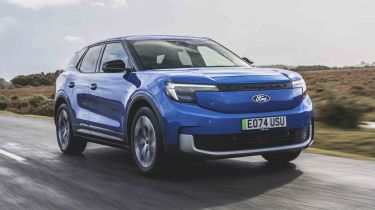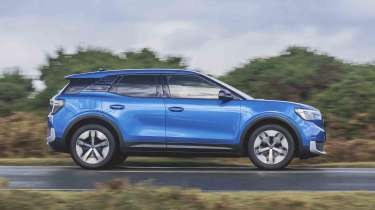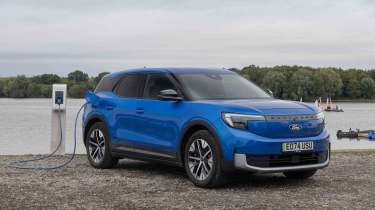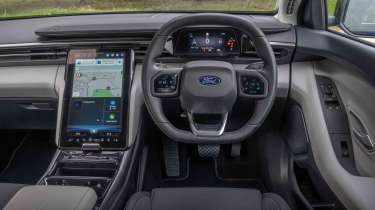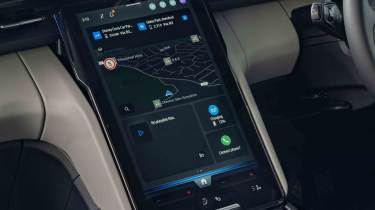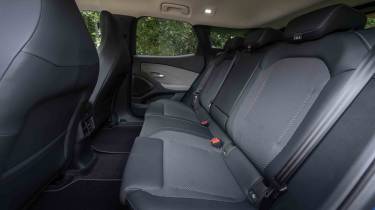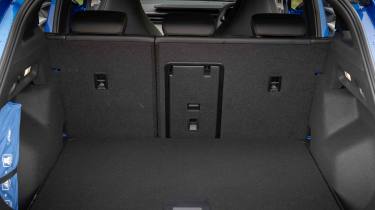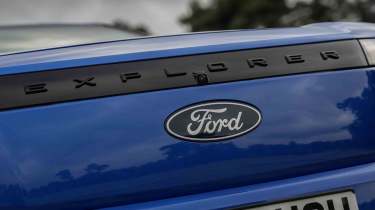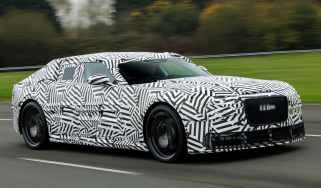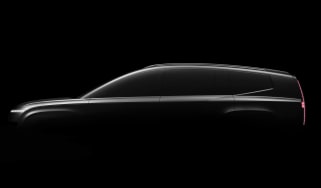Ford Explorer review – good-to-drive EV with a long range
“The Ford Explorer isn’t perfect, but its driving feel and long range help it stand out among rivals”
Pros
- Good to drive
- Better range than Volkswagen ID.4
- Well equipped
Cons
- Electric SUV rivals are cheaper
- Infotainment isn't the best
- Volkswagen-derived buttons are hard to use
Verdict – is the Ford Explorer a good car?
The Ford Explorer is a pleasant-to-drive electric SUV that’s well equipped and even boasts a better electric range than the Volkswagen ID.4 with which it shares many of its components. While its boot isn’t quite as spacious as rivals, it does boast a lot of interior storage space, but some of the materials used around the cabin are cheap-feeling, we’re not a fan of some of the Volkswagen switchgear, and it’s not the most affordable electric SUV from launch.
Ford Explorer models, specs and alternatives
You may or may not have heard of the Ford Explorer before – in the past it was only sold in the UK briefly, while it’s been more of a staple model over in the US. Now, though, it’s not only being sold in the UK, it’s been completely reinvented as a mid-size electric SUV. Ford has been controversially resurrecting iconic names from its repertoire of late, for example with the electric Capri, the Puma small SUV and the Mustang (in the form of the Mach-E EV), but using the Explorer name is arguably less polarising given that it never became such a household name over here and has always been an SUV.
Rather than designing its electric SUV from the ground up, Ford has partnered with Volkswagen to produce the Explorer, and it sits on the same underpinnings as the Volkswagen ID.4. At just under £46,000, the Ford Explorer costs around £1,000 more than the comparable Volkswagen ID.4 with the same 77kWh battery, but that car can already be had for a further £2,500 less with the smaller 52kWh battery.
Later Ford will release a cheaper entry-level version with rear-wheel drive and 172bhp paired with a smaller 52kWh battery like that offered with the ID.4 – that model is expected to cost from just under £40,000. From launch, though, the Explorer can be had in one of two configurations: a single motor variant producing 286bhp to the rear wheels or a dual-motor all-wheel drive model with a punchier 345bhp. The rear-wheel drive variant gets a 77kWh battery while the all-wheel drive Explorer gets a slightly bigger 79kWh battery.
More reviews
In-depth reviews
While the dual-motor version may have the larger battery, it’s the single-motor version that boasts the longest range. Its 77kWh battery will keep the Explorer going for up to 374 miles in Select trim, while the AWD Premium has a maximum range of 329 miles. The cheaper model arriving later has a range of just 239 miles.
There are just two trims available for the Explorer from launch: Select and Premium. Select gets the 286bhp rear-wheel drive setup, while Premium can be had with that motor or in dual-motor all-wheel drive specification. All Explorers get a decent amount of kit as standard, and Select models boast powered heated seats with a massage function and large 14.6-inch infotainment system among other features. Premium adds niceties such as a panoramic roof, B&O premium sound system, ambient interior lighting and a powered tailgate.
Following crash testing by Euro NCAP in September 2024, the Ford Explorer was awarded the full five-star rating, which should provide peace of mind. Unfortunately neither Ford nor Volkswagen (a brand that provides many of the Explorer’s parts) perform well in our Driver Power customer satisfaction surveys, coming in 30th and 29th out of 32 brands, respectively.
|
Trim levels |
Power options |
|
|
Range, charging & running costs
In comparison to its gas-guzzling predecessors sold over the pond in the US, the latest Ford Explorer is a fully-electric car which should mean it’s cheaper to run than you might expect of an SUV.
Despite the fact that the Ford Explorer is based on the same underpinnings as the Volkswagen ID.4, the Ford actually boasts the longer range. Rear-wheel drive single-motor 286bhp cars get the same 77kWh battery, but while the ID.4 can do up to 336 miles to a charge, the Explorer manages a maximum of 374 miles. Go for the all-wheel drive dual-motor version of the Ford Explorer with the slightly larger 79kWh battery and this maximum figure drops to 331 miles.
In 2025 a cheaper version of the Explorer will arrive with a smaller 52kWh battery; this will be capable of a much shorter 239-mile range. While it may be more affordable than the higher-spec Explorers at just under £40,000, rivals like the Renault Scenic have a much cheaper starting price while boasting a more competitive 260-mile range figure. Besides, for just under £41,000 you can get the Scenic with a better 379-mile range than the more expensive Extended Range Explorer anyway.
Frustratingly, a heat pump is not included on the Ford Explorer as standard and is an expensive option. Specifying one will help preserve range in colder temperatures by heating the battery to optimal operating temperatures, so without it you may notice much shorter range figures than quoted in chilly weather.
Once you do need to charge up, the dual-motor variant gets reasonably fast 185kW charging, while the single-motor variant’s charging speeds top out at 135kW – in practical terms it’s not that noticeable, though, because the dual-motor’s larger battery means it takes 26 minutes to charge from 10-80% while the single-motor car isn’t far behind at 28 minutes. Charging at home via a 11kW charger will take just over five hours, or approximately seven hours and 45 minutes with a 7kW charger.
|
Model |
Battery size |
Range |
|
RWD Standard Range | 52kWh | 239 miles |
|
RWD Extended Range |
77kWh |
374 miles |
|
AWD Extended Range |
79kWh |
331 miles |
What will the Ford Explorer cost to insure?
Electric cars are known for being a fair bit more expensive to insure compared to traditional petrol or diesel vehicles, but compare it to other electric rivals and the Ford Explorer seems to cost about the same to insure, spanning groups 28 to 32. The Renault Scenic spans the same insurance groups, while the closely-related Volkswagen ID.4 sits in group 27. Go for a Tesla Model Y and insurance jumps into the 40s, while even the Hyundai Ioniq 5 maxes out in group 44 if you go for the larger-battery all-wheel drive variant.
Electric motor, drive & performance
Ford has long had a reputation for making cars that are fun to drive, so even though the Explorer shares many of its components with the Volkswagen ID.4 – a car that isn’t particularly exciting to drive – the brand has sought to differentiate it by revamping many of the suspension and chassis components.
As a result, the Explorer really is much better to drive than its Volkswagen counterpart. It features a stiffer suspension setup than the ID.4, however, so the downside is that it doesn’t soak up road imperfections quite as well and can feel quite unsettled as a result, especially at lower speeds. We thought the smaller 19-inch wheels might improve things compared with the 20-inchers but there was not much of a difference when we compared them back to back.
When you pick up the pace, the Ford Explorer’s ride does smoothen out a bit and the low centre of gravity thanks to the battery in the floor means there’s little body lean.
Like with many other EVs, you can activate the Explorer’s regenerative braking by changing it from ‘D’ into ‘B’. Doing so will allow it to put energy that would otherwise be lost to braking back into the battery by lifting off the throttle and allowing it to slow down. Unfortunately unlike in many rivals there’s no ability to tweak the settings and strength of this feature, and it’s not quite strong enough for one-pedal driving, which is disappointing.
Is the Ford Explorer good to drive in town?
Yes, the Ford Explorer feels very manoeuvrable for a car of its size, and we were impressed with its tight turning circle which comes in useful in tight urban environments. Visibility in the Ford Explorer is good, helped by the fact that the C-pillar is actually transparent from the inside despite having a graphic on the outside.
Is the Ford Explorer good to drive on long journeys?
The Ford Explorer is much more comfortable at higher cruising speeds, which makes it adept at covering motorway miles. There’s very little road and wind noise which contributes to a serene cabin environment, and it feels well planted. There’s enough power at any speed to comfortably overtake other vehicles on the motorway, too.
Is the Ford Explorer good to drive on B-roads?
The Ford Explorer does a good job of mitigating body roll despite its size and weight, so it feels stable weaving in and out of twisty B-roads. The steering is well weighted and direct, but there’s not all that much feedback through the wheel.
|
Model |
Power |
0-62mph |
Top speed |
|
Standard Range RWD |
172bhp |
TBC |
99mph |
|
Extended Range RWD |
287bhp |
6.4 seconds |
112mph |
|
Extended Range AWD |
345bhp |
5.3 seconds |
112mph |
Carbuyer notes
“Ford has focused on the car’s suspension and electronics to ensure that it delivers the kind of entertaining handling the company is famous for.” Dean Gibson, senior test editor
Interior & comfort
The interior of the Ford Explorer uses an odd mix of materials, some of which feel higher in quality than others. There are softer plastics used higher up where you can see and touch them, and we like the way these elements can vary in shape and colour to add a little interest. Lower down the quality takes a bit of a nosedive with scratchy harsh plastics, and even some areas you’re likely to touch often, like the door grab handle, feel cheap to the touch.
Unfortunately Ford opted to keep much of the switchgear used in the Volkswagen ID.4, which we aren’t particularly fond of. For example, there are two window switches on the driver’s side with a touch-sensitive button to toggle between the front and rear windows, but it just seems like an overengineered and non-intuitive alternative to simply having four switches.
Is the Ford Explorer’s infotainment and navigation system easy to use?
The Ford Explorer gets a large 14.6-inch infotainment screen mounted in a portrait configuration that dominates the dashboard. We like the fact that it can be tilted to your preference, too.
While the screen is great for displaying the sat nav and maps effectively, it’s not the most intuitive to use. We don’t like the sheer amount of inputs you have to do to turn off the many driver assistance systems, although the ability to configure shortcuts at the top of the screen is a nice addition. There are some touch-sensitive buttons on the steering wheel, too, but they’re hard to use on the fly – we found ourselves getting distracted trying to see which buttons were which, as they’re not as easy to feel as conventional physical controls.
Is the Ford Explorer well equipped?
The Ford Explorer is well equipped and comes with features like the large infotainment screen, heated front seats with a massage function for the driver, a heated steering wheel, seven-speaker sound system with a sound bar, wireless smartphone charging, LED headlights and adaptive cruise control among many more features on Select trim. Premium adds a more upmarket B&O sound system, a panoramic roof, ambient interior lighting and matrix LED headlights among other additions.
What options should you choose on the Ford Explorer?
Unfortunately rather than being standard on the Ford Explorer, a heat pump must be specified as an optional extra costing £1,050 at the time of writing. It’s a useful addition because it helps to heat the battery to optimum performance temperatures in colder weather, preserving the quoted electric range.
Other options include the Driver Assistance Pack, which brings a head-up display, lane centering and lane change assist, a 360-degree parking camera with parking assistance tech and a hands-free powered tailgate (standard on Premium models). You can also specify a tow bar and dog guard if you need to transport your four-legged friend around with you.
Key features | |
|
Select
|
Premium (Select plus…)
|
Practicality & boot space
The Ford Explorer is a five-seater SUV and there’s no seven-seater option so it won’t be suitable for much larger families. That said, the five occupants do get lots of foot room thanks to the Explorer’s completely flat floor. Headroom is also plentiful, so the Explorer should be a comfortable car to ride in on longer journeys. Our only qualm is the fact that the floor is quite high as it houses the battery beneath it, so you might find your knees come up quite high as a result.
There are lots of storage solutions dotted around the cabin, including a massive compartment below the centre armrest which Ford calls the Megaconsole. It’s a useful space you could use to store a laptop out of view while the car’s parked, for example, or even several large drink bottles. Less impressive is the storage space in the door bins, which are quite tight and less useful, incapable of even storing a small drink bottle.
|
Size comparison | |||
|
Model |
Length |
Width |
Height |
|
Ford Explorer |
4,468mm |
1,871mm |
1,630mm |
|
Volkswagen ID.4 |
4,584mm |
1,852mm |
1,632mm |
|
Volvo EX40 |
4,425mm |
1,873mm |
1,651mm |
|
Tesla Model Y |
4,751mm |
1,850mm |
1,600mm |
Does the Ford Explorer have a big boot?
The Ford Explorer has a reasonably-sized boot, but at 445 litres it’s not class leading. Fold down the seats and you free up 1,417 litres of space. The Renault Scenic, Skoda Enyaq and Volkswagen ID.4 have much more space. There’s at least some useful features back there, though, such as a 12V socket and an adjustable boot floor to make it more configurable.
|
Boot space comparison | |
|
Model |
Boot space |
|
Ford Explorer |
445 litres |
|
Volkswagen ID.4 |
534 litres |
|
Skoda Enyaq |
585 litres |
|
Renault Scenic |
572 litres |
Is the Ford Explorer a good tow car?
The Ford Explorer comes with the option of a tow bar, but a towing capacity of up to 1,200kg is quite modest, so you’d only really be able to pull a modest-sized trailer for tip runs and the like.
Reliability & safety
The Ford Explorer is too new to have featured in our latest 2024 Driver Power customer satisfaction survey, but as a brand it doesn’t look great for Ford, which finished in 30th place out of 32 manufacturers. It scored poorly in terms of quality, ride and handling, practicality, interior and exterior design and its powertrains, with its highest rating in MPG and running costs where it came 21st. Reliability as a brand isn’t too bad, with 21% of owners reporting an issue with their Ford in the first year.
Really, though, you ought to also consider Volkswagen’s performance given how much the Explorer shares with that brand’s ID.4 and ID.5 models – the bad news is that Volkswagen didn’t do much better, coming in 29th place with around 23% of owners reporting an issue with their car in the first year.
How safe is the Ford Explorer?
The Ford Explorer was crash tested by Euro NCAP in September 2024 and achieved the full five-star rating. It scored highest in the adult occupant and child occupant protection categories where it received 89% and 86%, respectively. In the category for vulnerable road user protection it was awarded 80%, while it received 72% for its safety assist equipment. The autonomous emergency braking technology was found to be responsive, helping reduce the risk of collisions.
What are the Ford Explorer service intervals?
Ford recommends getting the Explorer serviced every two years, with no particular mileage service interval. The brand offers the first 5 years’ worth of servicing and Ford Assistance (roadside rescue, repair and recovery for 365 days a year) free of charge.
What is the warranty on the Ford Explorer?
Ford’s warranty covers its cars for the first three years or 60,000 miles, whichever comes first. This used to be the industry standard, but with other companies now offering more comprehensive warranties, it’s starting to sound a little lacklustre. As the Ford Explorer is an electric vehicle, Ford also guarantees that the Explorer’s battery capacity won’t drop below 70% within eight years or 100,000 miles.
Should you buy a Ford Explorer?
While the Ford Explorer is a good electric vehicle and helps to further the brand’s move towards zero-emissions motoring for the masses, it’s not particularly a game-changer. It has some very positive attributes, such as a satisfying driving feel which doesn’t compromise the car’s comfort, with Ford’s engineers having successfully differentiated it from the Volkswagen ID.4 in this respect. It also boasts a much better range than that of equivalent versions of its Volkswagen ID.4 sister car, and feels well equipped too.
Where it falls behind somewhat is on the interior, where some of the material choices are a bit sub-par for a car of this price. The infotainment system can also be frustrating to use, as are many of the touch-sensitive buttons, and this is an area where we would have preferred Ford to have replaced the Volkswagen-derived switchgear. The Ford Explorer is not cheap either, though a more affordable entry model could make it more accessible, and many of its rivals boast better boot space.
What is the Carbuyer pick of the Ford Explorer range?
If it was our money we’d stick to the rear-wheel drive version of the Ford Explorer, given that it has the longest range and an adequate amount of power for most scenarios. Given that it’s well equipped as standard, we’d also be happy enough with the current entry-level Select trim with that large infotainment screen, wireless phone charging and heated front seats with a massage function.
Ford Explorer alternatives
Aside from the Volkswagen ID.4 on which it’s based, the Ford Explorer now has a fair few electric SUVs and family cars to compete with from many rival brands, and this is a rapidly growing sector of the market.
